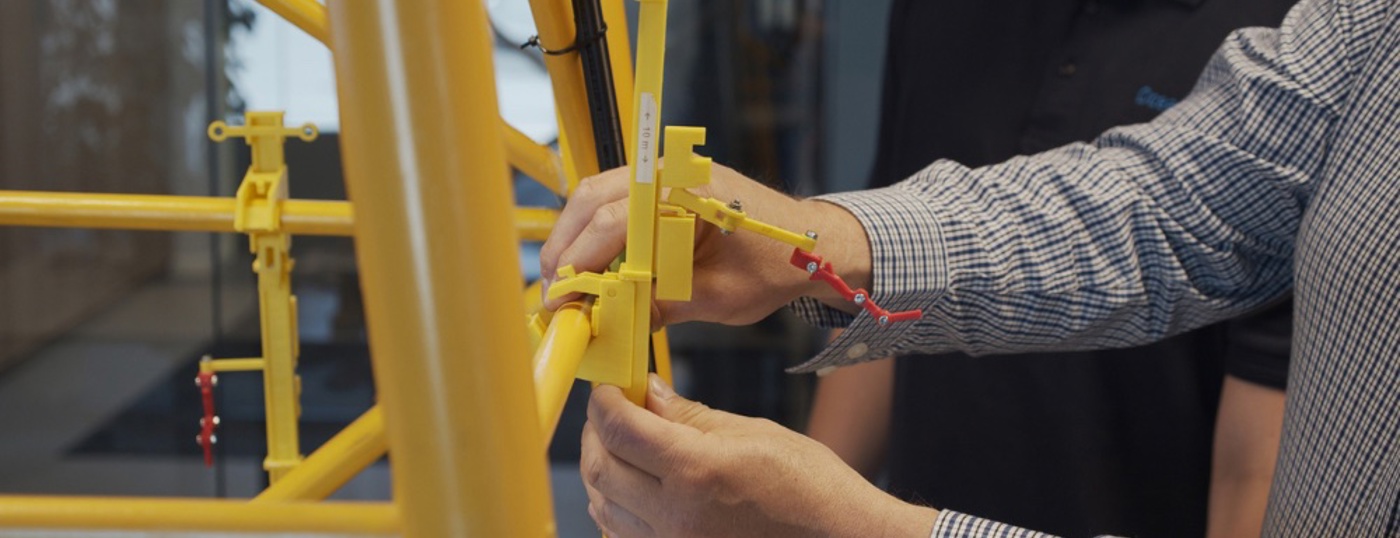Prior to the sale of its Danish subsidiary Hess Denmark in 2021, U.S. oil and gas company Hess Corporation operated the South Arne platform in the Danish sector of the North Sea.
Located in shallow waters 250 kilometers west of Esbjerg, the platform plays a significant role in Denmark’s energy supply and economic activities in the region.
The South Arne platform relies on risers within the steel jacket structure for safe and efficient extraction, transportation, and processing of hydrocarbons from the subsea wells to the surface facilities. Transport fluid and outer seawater flow expose risers to internal and external corrosion. This is a significant challenge in the splash zone due to the environmental factors and conditions above and below the waterline. Preventive measures such as protective coatings and regular inspections are crucial to mitigate corrosion and ensure riser integrity and longevity.
Hess Corporation required our services at the South Arne platform. The company requested we inspect the condition of the R2 and R3 risers in the splash zone and apply protective coatings to prolong their service life if necessary.
Unlocking the challenge: Riser inspection within jacket structures
Regular inspections allow operators to proactively address safety concerns, ensure regulatory compliance, and assess the integrity of structures, pipes, and conduits like risers. This enables companies like Hess Corporation to evaluate the remaining service life of structures and components while determining the need for maintenance, repairs, or replacements.
While riser inspections are crucial for operational reliability and efficiency, they pose several challenges. This is due to the nature of their installation and the harsh conditions in the difficult-to-access splash zone:
- Risers may be in a confined space within the jacket structure.
- Weather conditions and operational schedules can complicate logistics and access.
- Personnel safety requires rigorous safety protocols and training.
- Inspection tools should be capable of capturing accurate data, especially given the often restricted access and confined spaces around the risers.
- Specialised techniques, such as ultrasonic testing, corrosion monitoring, and cathodic protection assessment, may be required to evaluate the condition of the risers and identify areas of concern.
Both diver and remotely underwater vehicle (ROV) inspections have advantages and disadvantages. Diver inspections allow for a direct human presence but are typically limited by safety considerations and restricted access. ROVs offer the advantage of remote operation and the ability to navigate difficult-to-reach areas. However, ROVs may face limitations in terms of manoeuvrability in strong currents and their ability to conduct tactile inspections.
A robotic solution is often necessary for riser inspections in the splash zone. OceanTech’s inspection solutions offer a fixed and stable platform to deploy sensors, cameras, probes, and other inspection tools. These tools would be impractical or impossible to use with divers or ROVs, but combining them with OceanTech’s robotic solution allowed the team to successfully assess the South Arne platform risers.
Rigorous preparations at the Subsea Test Center
OceanTech’s Subsea Test Center in Trondheim provides full-scale testing of equipment, tools, and techniques in wet and dry conditions before undertaking any offshore projects. Our inspection techniques include visual and non-destructive testing (NDT) techniques specialised for splash zone and underwater structures, including:
- General visual inspection (GVI)
- Close visual inspection (CVI)
- Cathodic protection (CP) measurements
- Ultrasonic thickness (UT) measurements
- Pulsed eddy current (PEC) thickness measurements
- Alternating current field measurements
For the South Arne riser project, OceanTech undertook rigorous testing of multiple cleaning methods, inspection tools (including vertical access tools), and protective wrapping three months before offshore execution.
Regarding pre-inspection cleaning, the combination of brushes and scrapers demonstrated the most effective results. Using our clamp access tool and a camera attached to the robotic arm, our team can check for possible corrosion. We can discover any degradation, even in confined spaces within jacket structures. Our tools and techniques do not require divers, ROVs, or support vessels to verify structural integrity.
At the South Arne risers, we detected pitting corrosion and applied protective wrapping following an inspection. Protective wrapping acts as a barrier between the riser material and the offshore environment’s corrosive elements like seawater and oxygen. Typically, these protective measures include anti-corrosion coatings, such as fusion-bonded epoxy (FBE) or high-density polyethylene (HDPE) coatings, which we apply to the riser surfaces.
Accelerated project delivery
We completed the South Arne riser cleaning, inspection, and application of corrosion protection wrapping with a team of five in only three weeks offshore. The efficiency of our robotic solutions offers several Personnel on Board (POB) benefits for platform operators like Hess Corporation:
- The swift execution allows operators to allocate personnel resources more efficiently, enabling them to focus on other critical tasks and operations.
- Minimising the duration of riser maintenance activities reduces or eliminates downtime, translating to increased productivity and improved revenue generation.
- Finalising riser inspections in only three weeks minimises the overall safety risks associated with prolonged operations.
- Completing tasks within a condensed time frame facilitates better planning and scheduling of other maintenance activities.
- Efficient execution of riser maintenance activities can result in significant cost savings for operators.
Conducting riser inspections in the splash zone can be a laborious and expensive process, accompanied by safety concerns for the personnel involved. Moreover, performing inspections within confined spaces can present formidable challenges, making manual or non-automated solutions impractical or unfeasible.
The OceanTech team employed its robotised inspection solution and successfully assessed the condition of the South Arne risers. This allowed Hess Corporation to continue operations seamlessly without any disruptions. Our streamlined approach saved time and costs while ensuring personnel safety.
